18 Peruvian Foods You Need To Try At Least Once
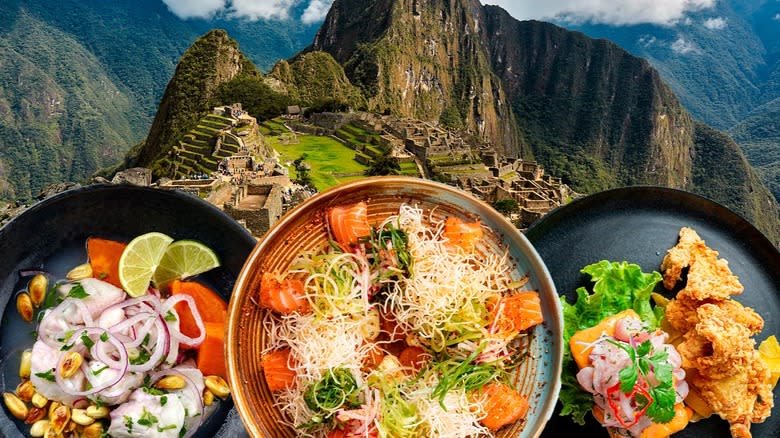
Gastón Acurio once famously told 52 Insights that international cuisines can be used as "a weapon for change" — and given what the world-renowned chef has done for the food of his home nation of Peru, perhaps nobody understands this better. Eating in Peru is like eating nowhere else; the country has an abundance of unique ingredients and culinary traditions that span thousands of years, during which cycles of indigenous rule, colonization, immigration, and diaspora have ebbed and flowed. As someone who has spent extensive time traveling Peru, it's clear to me that this melting pot of a dining scene is due every bit of the respect it continues to have on the world's stage.
When you are in Peru, there's almost as many styles of eateries as there are dishes to line the tables. Small, family-owned huariques are the bastions of culinary traditions that span lifetimes. Upscale, white-clothed restaurants offer journeys through Peruvian cuisine as it has stunned the world. Chifa spots give you a taste of Chinese and Peruvian techniques and ingredients, a cuisine that is the work of a century-plus of cross-cultural exchange.
Time is relative when studying Peruvian food; even a two-month visit to the country feels like only a few hours of exploring. We've narrowed down some of the Peruvian foods you'll want to try at least once.
Read more: 25 Most Popular Snacks In America Ranked Worst To Best
Ceviche
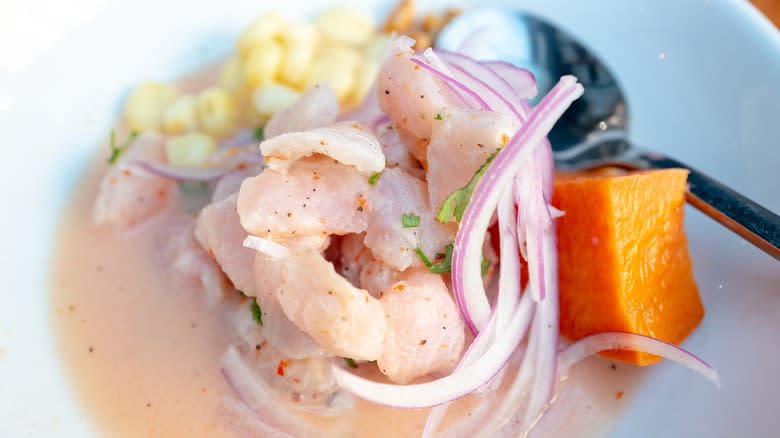
Classic ceviche is perhaps the most iconic Peruvian food, or at least the one with massive reach. The dish is made from a wide selection of seafood, so you're as likely to find it including perjerrey fish as you are prawns or even sea urchin. If you haven't tried ceviche, you are in for a treat.
Fresh seafood is soaked in lime juice and salt, a process which "cooks" the fish by rearranging the protein structure. It imparts a duo of flavors: salinity and acidity, complemented by the heat of minced pepper and thin slivers of red onion. A heap of cilantro adds an herbaceous note, and most Peruvian ceviche dishes are served with thick slices of cooked sweet potato for a cooling side that's slightly sweet, earthy, and filling. You'll also see large a piece of corn cob or oversized corn kernels, known as choclo.
Tiradito
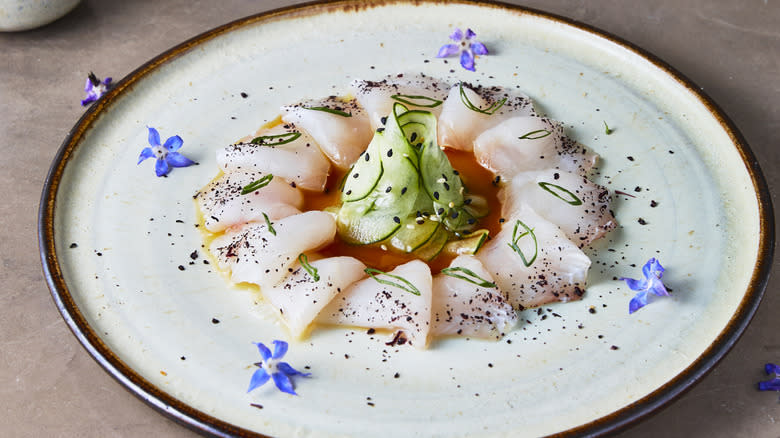
Ceviche is the worldly ambassador of Peruvian cuisine; tiradito is the spicy representative of how the cuisine has been influenced over generations. Tiradito has many similarities to classic ceviche in that both depend on quality, fresh fish. However, there are some key differences between the two styles. For one, in tiradito, the fish is cut as sashimi would be, belying this as a signature dish of Nikkei origin. While you might find thin cuts of traditional ceviche, less attention is given to the cut as a special step. You may find ceviche where the fish has been cubed.
Another difference in tiradito is ají amarillo, a Peruvian yellow pepper that is blended in the sauce. The pepper is flagrantly floral and adds a shocking color and ethereal flavor to an otherwise lime- and ginger-heavy sauce. The dish is served cold.
Causa
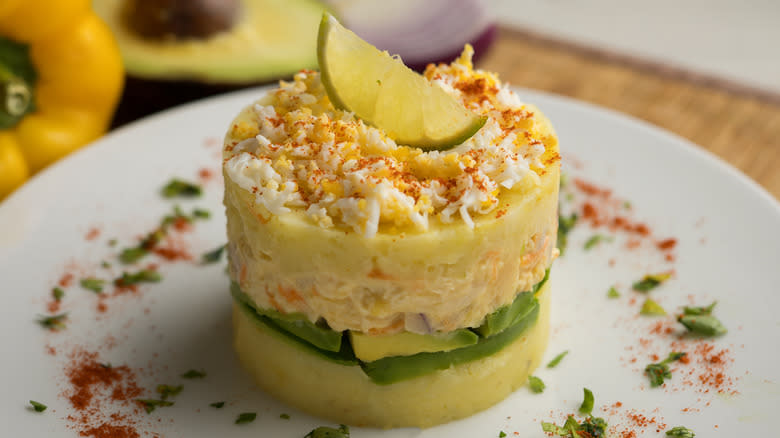
Causa is a dish that exposes many of the unique dichotomies within Peruvian cuisine. The ingredients are comfort foods, some of which you might expect to find at a backyard barbecue in the United States: mashed potatoes, shredded chicken, and a slather of mayo. Yet, causa comes in a sleek, stacked shape and a vibrant color. Because of the addition of ají amarillo, the mashed potato base is a vivid yellow that is especially sharp when contrasted by verdant avocado filling.
Despite a sophisticated presentation, it remains a casual bite with few declared rules — meaning, chefs take liberty with the makeup of the dish. Along with chicken or avocado, you can find causa filled with octopus, mushrooms, tuna, or even river trout from the Andean Mountain range around Cusco.
Papa A La Huancaína
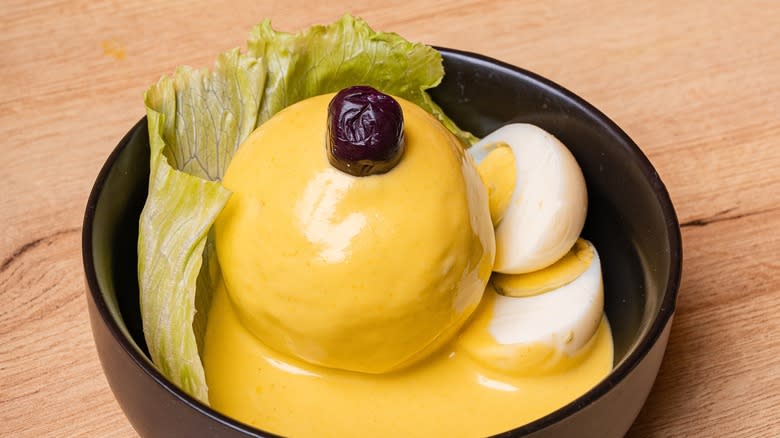
Papa a la huancaína translates roughly to potatoes in the women of Huancayo's style, as the dish is named for the Andean city of Huancayo, from which it originated. The potato-based dish is eaten as a cold starter and is another plate where the famous ají amarillo pepper appears. As it's typically prepared, a plate of papa a la huancaína will feature boiled and sliced potatoes topped with boiled eggs, black olives, and a spicy, cheesy, peppery sauce.
When visiting Peru, it can be an adventure just to try papa a la huancaína from different eateries, as each restaurant makes the sauce differently. Main ingredients consist of charred ají (or paste), garlic, salt, milk, and a queso fresco. However, a big variable is the texture. Some restaurants serve the dish with a thick texture made chunky by crushed crackers. Similarly, preparation in a batán, or large mortar and pestle, can lead to a rustic mouthfeel. If your huancaína sauce is smooth, chances are it was blended.
Papa Relleno
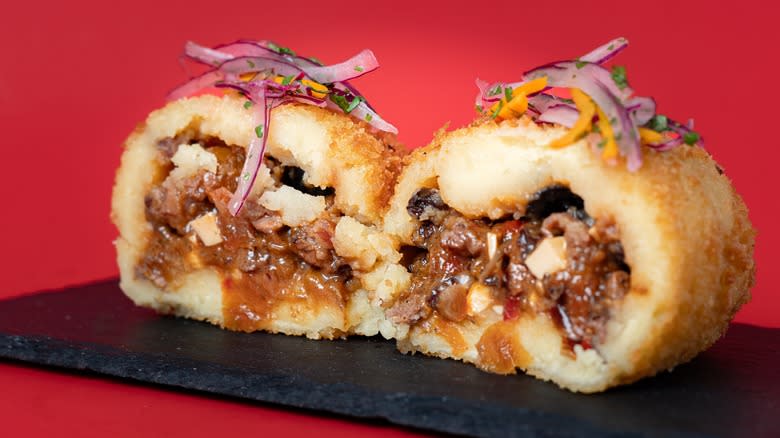
One Peruvian dish that makes use of the abundance of potatoes but leaves out the ají amarillo is papa relleno. This is a stuffed potato that arose out of necessity as a food that could easily be consumed by soldiers on the road. Now, it holds a position of ubiquity on Peruvian tables, with diners able to find it in small- and large-sized restaurants alike.
Few ingredients are needed for papa relleno. A rough dough is made from par-cooked potatoes. A base of this dough is laid out and topped with ground meat of any type, plus spices and chilis. The ground meat is surrounded by more potato mix and then formed into a ball. Then, it's coated with flour and pan-fried. The result is a friable lump with a decadently tender internal texture, punctuated by the salinity and umami of seasoned meat.
Carapulcra
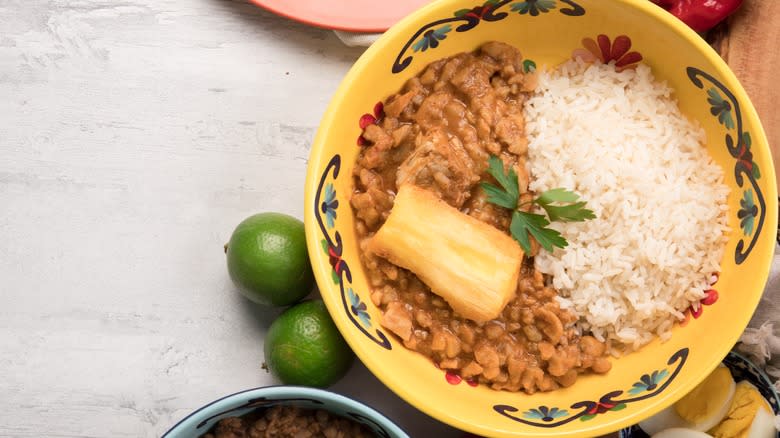
Carapulcra, also known as papa seca, is a dish you're likely to find in criolla restaurants all across Peru. Criolla is a Peruvian style of Creole cooking — that is, it's an amalgam of influences. That said, carapulcra has origins that can be traced to Inca cooking more than 500 years ago.
In essence, this dish is a spicy pork stew served over white rice. Along with ají amarillo, the sauce also includes ají panca, a red pepper that is slightly more capsicum than its orangey-yellow cousin. Spices such as cinnamon and star anise are common in the beef-based sauce, which can also include ground peanuts in it (otherwise, they're served as a garnish). Carapulcra is commonly made of pork shoulder, though refined versions, such as that served by the Awicha restaurant in Lima, use pork belly.
Lomo Saltado
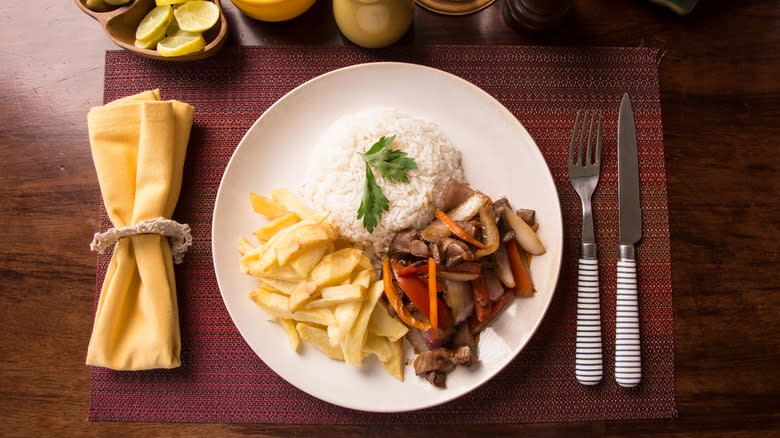
Lomo saltado is a Peruvian food you'll find in eateries across the country, whether at chifa joints, in huariques, or even in bodegas, too. The recipe for lomo saltado makes a stir-fry dish; the name also refers to the cut of meat used in the dish.
Lomo translates to loin, so your dish might contain sirloin, tenderloin, or even strip steak. Alongside the meat, you'll taste seared peppers, red onions, and tomatoes. Combined with garlic, ají amarillo, and cilantro, the dish is served alongside thick, steak-cut french fries. Lomo saltado is an umami-full, layered dish. It has equal protein and vegetables, but a double serving of carbs (thanks to a heap of rice). The mark of a good lomo saltado is tender meat and charred — not burnt — flavors.
Arroz Con Mariscos
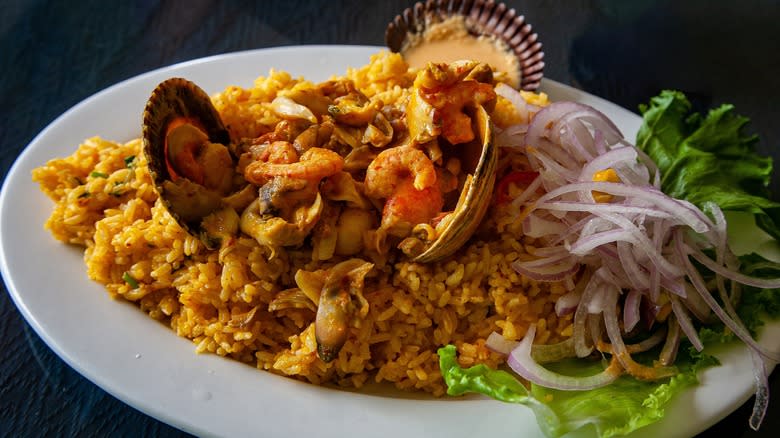
Arroz con mariscos, or rice with shellfish, is a dish of rice and seafood with a creamy texture and a flavor that cascades across your mouth like a wave. The base, a bright marigold-orange, is made from a seafood broth, tomato paste, garlic, and ajís panca and amarillo. Bound to contain shellfish, it often has squid or fish as well.
The silky-smooth mouthfeel is accented by the inclusion of Parmesan cheese. This ingredient reveals the potential colonial heritage that resulted in its fused creation. As a fresher component, arroz con mariscos also has peas and minced bell pepper, both of which add a lifting garden quality to the plate. You'll find this dish is cevicherias all across Peru. Wherever you go, make sure there is a sizeable lime wedge to top it with.
Ají De Gallina
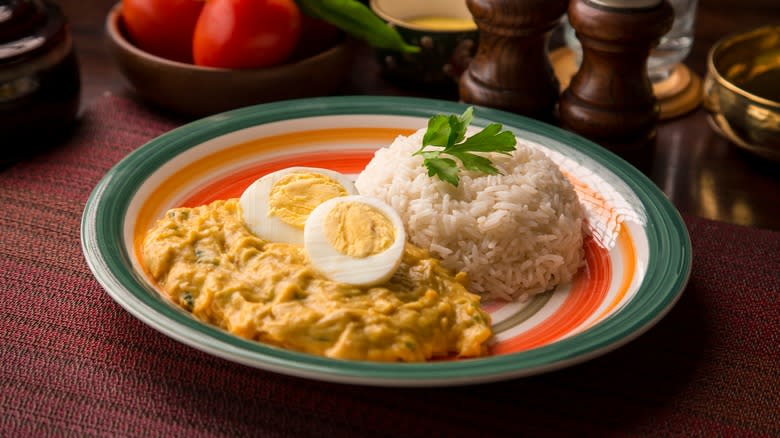
Along with being uniquely noshable, ají de gallina holds an important cultural role in the foods of Peru. Its origin is traced alongside the arrival of manjar blanco — a caramelized milk from Catalonia, Spain. The dish took many different shapes throughout Peru's colonial history to become what it is today, a spicy chicken stew made from simple ingredients. It stands as an example of the tenacity and adaptability of colonized people.
Rice, egg, and shredded chicken are the bulk of the dish, but the sauce is no slouch either. Along with onions, garlic, and the sacred yellow pepper, the stew mixture also contains soaked bread blended into a dough. Bonded to the dairy, it's a thick, glossy mixture that you're liable to eat by the spoonful.
Pollo A La Brasa
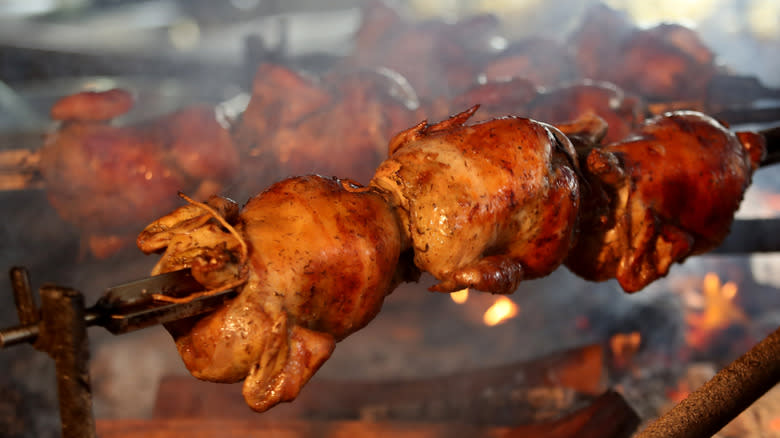
Peruvian rotisserie chicken is a storied part of the nation's cuisine. But despite what it may seem, the dish -- chicken over embers -- isn't old. When it first emerged into the nation's culinary consciousness during the 1950s, it upended eating habits of the time. The accessibility of spit-roasting chicken and the low cost of selling it was opposite of what was traditional of Lima restaurants in the mid-20th century. Its growth hasn't slowed down since.
Many cultures have recipes for roasted chicken, but what makes pollo a la brasa unique is the combination of spice rubs and side sauces. The crust on the chicken derives from a set of ingredients special to each bird roaster, but huacatay -- a type of mint -- along with beer or even pisco might be part of the rub. It comes served with ají verde, a spicy, herbal Peruvian green sauce similar to chimichurri but with more heat and less oil.
Cuy A La Brasa
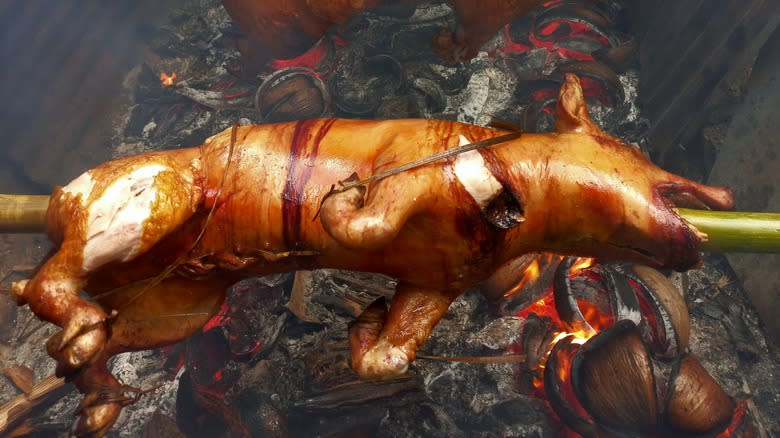
You might think of guinea pigs as a pet, but in the Peruvian highlands, it's much more common to see them spit-roasted as a meal. Similar to pollo a la brasa, cuy is cooked over wood embers in barbecue fashion. The animal has been a source of nourishment since Incan times and is still commonly eaten in the Andes.
Cuy is richer and oilier than chicken, somewhere along the lines of a greasier duck with the body of turkey meat. It is gamey like rabbit meat but has more substance to it. A good cuy should have brittle skin but a tender interior, and much of the flavor is instilled from a dry rub of mixed spices. It should come served with corn, or choclo, and a side of spicy sauce.
Chaufa
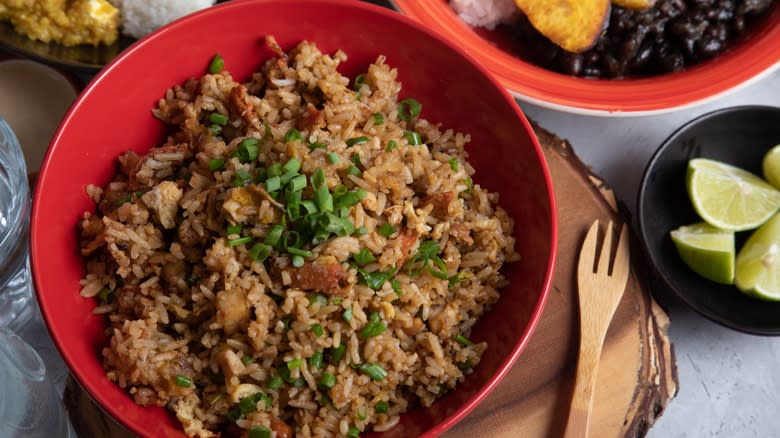
Arroz chaufa is a dish you are bound to see across Peruvian restaurants of all shapes, styles, and sizes. It is a form of fried rice and is perhaps the most iconic chifa dish, a cuisine that marries Peruvian ingredients and Chinese cooking techniques. The plate's ubiquity comes from many things, not least of which are its readily available ingredients and delicious flavor.
Chaufa is made of aromatics such as soy sauce and ginger. Sometimes, umami is imparted with Ajinomoto, a brand of MSG — and that taste also comes from a mix of vegetables, egg omelet, and a protein (for example, arroz chaufa con pollo would be fried rice with chicken). A good chaufa is made from a careful preparation, with each component layered for a well-composed texture.
Pan Con Chicharrón
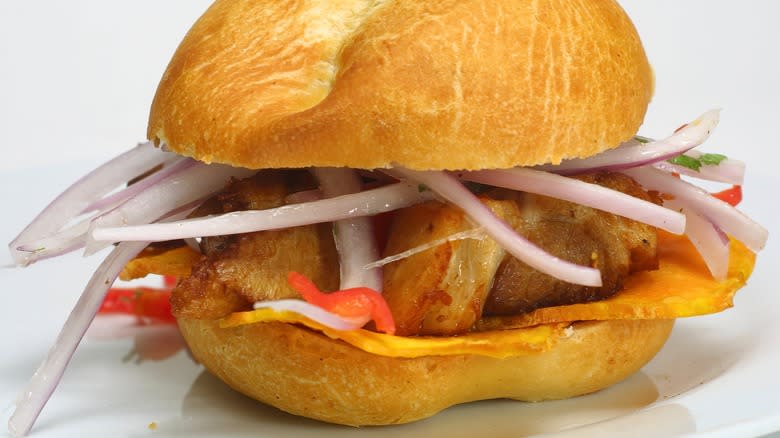
With no exaggeration, allow me to say that biting into a good chicharrón sandwich is a moment of pure and simple joy. It is the balance of all things we crave: sweet and salty, acidic, herbaceous, bready, and maybe a bit spicy. It's hot clashing with cold -- and it may just leave you thinking about life before the bite, and after.
Pan con chicharrón is pork belly, cured and crispy fried. Sliced into a thin slab, it's layered between a bread roll with a thick slice of sweet potato and dressed with salsa criolla: red onion, cilantro, and maybe some hot pepper brined with vinegar and citrus. You will definitely see chicharrón used to describe more than just this sandwich, as there is chicharrón of squid, chicken, and fish as well. These are all well and good, but pan con chicharrón eaten for breakfast at a sandwich shop with a piping hot coffee makes for a very good moment.
Arroz Con Pato
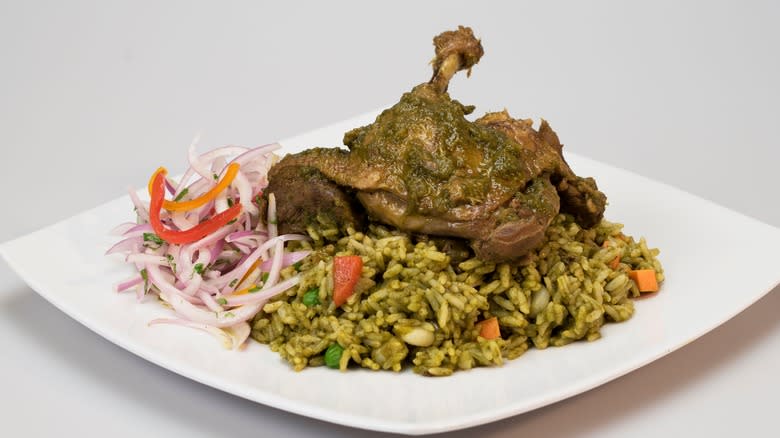
Duck meat, specifically from Muscovy ducks, has been a valued animal protein for Peruvians since pre-Incan times, when the bird was first domesticated. This dish, arroz con pato, derives from north of Peru in a city called Chiclayo. Its creation is another mix of different culinary and cultural traditions.
A bed of Cantonese-style fried rice is prepared and includes a mix of panca or guajillo peppers. A bottle of beer goes in the mixture, with aromatics and alliums. Then, a quartered duck leg is confited or roasted, and then plated atop the amber-colored rice. The immersion of influences coalesces to a savory, earthy, grounding food that's both humble and impressive. Make sure to finish it with citrus, and consider washing it down with a cold, dark beer.
Seco De Carne
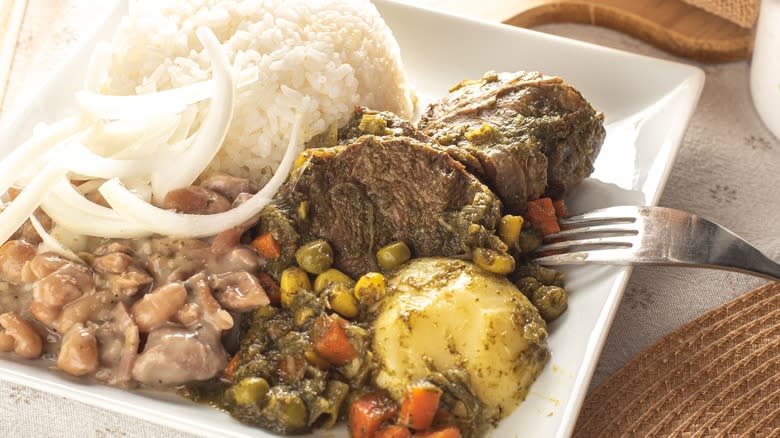
You may see this called seco de res as well as seco de carne depending on where you are. But all across Peru, its essence is the same: cilantro and beef stew. It is the regional variation of a mutton dish from northern Africa called seco tajine, both of which are long, slow-cooked ordeals. In this case, it is beef stewed with cilantro, coriander, cumin, and ají amarillo in a broth that's simmered, reduced, and reduced more.
Potatoes, carrots, peas, or peppers may be added close to the end, padding the stew's nutritional profile and thickening it, too. If you're in the right place, your seco de carne will be prepared with culantro, which is a local herb that's bolder than what U.S. diners might be used to. Gently touched by the fruity spice of ají amarillo, the flavor of this Peruvian dish makes it hard not to eat it rapidly and by the large spoonful.
Anticuchos
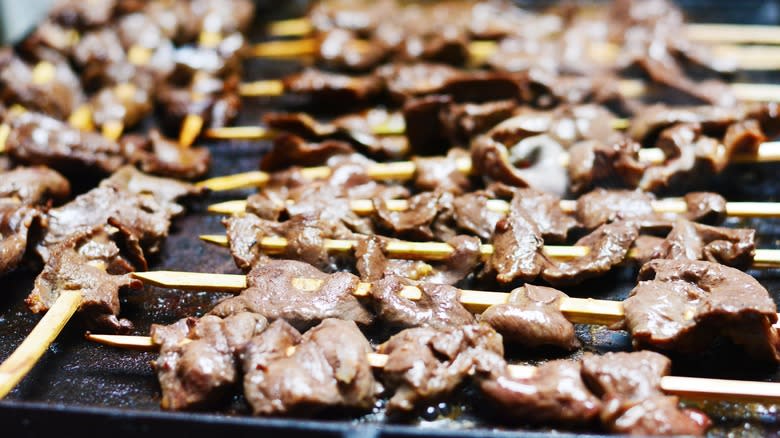
Anticuchos are skewers of beef heart served grilled or roasted. It's a commonly eaten street food that has a history traceable to the Incan empire, colonization, and slavery. The name might even be a Spanish mutation of the Quechuan words anti (Andes) and kuchu (cut). Quechuan is an indigenous language of Peru that boasts millions of speakers today.
The name suggests that the dish comes from the mountains, but it's the beating heart of Peruvian cuisine in that even its simple form affirms the varied identities that it represents. Offal cuts like heart were often given to slaves, who adapted ingredients from Asia, Spain, and Africa to create regional marinades and sauces that adorn and infuse anticuchos to this day. The cuts of heart are thinly sliced and available at almost every street corner restaurant. When you get the taste, it's hard to still your own beating heart.
Rocoto Relleno
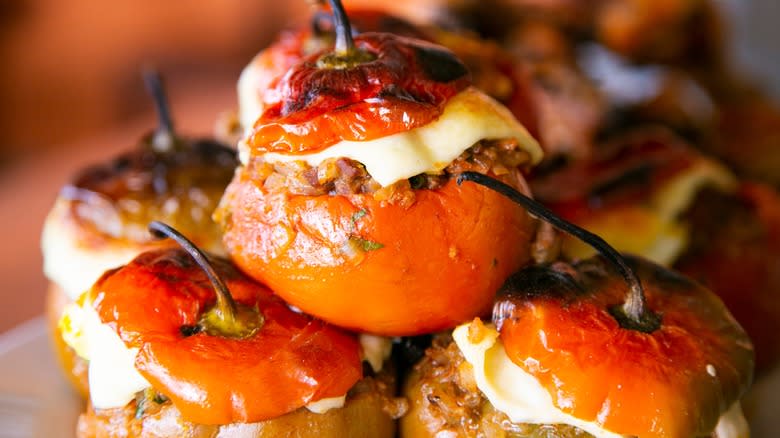
Just like papa relleno, rocoto relleno is a stuffed piece of produce. But this Arequipa-associated dish has a lot more vim and vigor than the comforting fried potato. Rocoto peppers look like a bell pepper but have magnitudes more capsicum than a jalapeño. The burn of it has some surprising nutritional benefits, including loads of antioxidants and vitamin C. The pepper has been cultivated by southern Peruvians for 5,000 years or more, and this dish tastes like the culmination of that storied history.
To reduce the impact of the heat, rocotos are boiled. Then, the pepper is stuffed with ground or cubed meat, hard-boiled eggs, and seasonings. Milk may be used to bind the filling together, and sometimes the mixture or toppings include raisins, peanuts, and cilantro. The stuffed pepper is then topped with fresh white cheese and baked.
Tacu Tacu
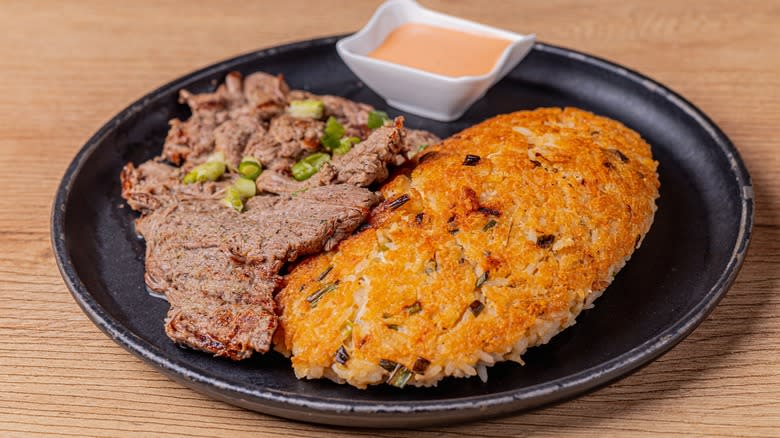
Scholars debate whether the nomenclature of tacu tacu comes from the Quechua or Swahili language, a fact that can clue knowledgeable diners into the influences of this meal. Tacu tacu is a plate of rice and beans, mashed into a dough, and then pan-fried; a composition, technique, and flavor that belongs as much to South America as it does Africa.
In this way, the dish offers an amazing method for cooking with leftover rice and beans. It's a subsistence dish that also fills a hungry belly with comfort. There's a freedom in its form as well, since cooks can use up whatever they happen to have on hand and include any number of added ingredients in the friable crust. Because of its carby neutrality, you can eat tacu tacu with an egg for breakfast, or under a saucy meat stew for dinner. Similarly, any leftover beans or rice will work, meaning no two tacu tacu dishes are exactly the same.
Read the original article on Tasting Table


